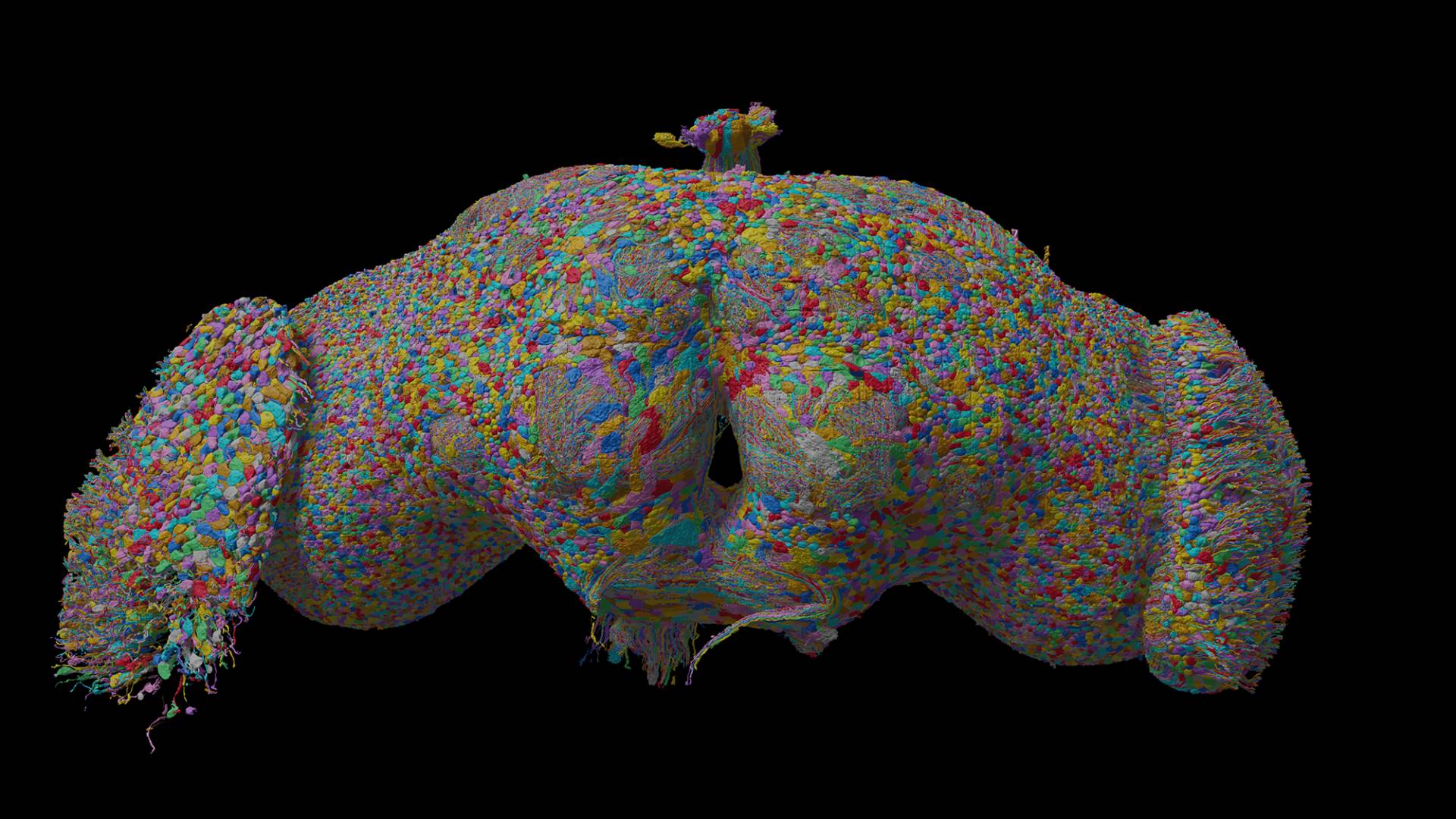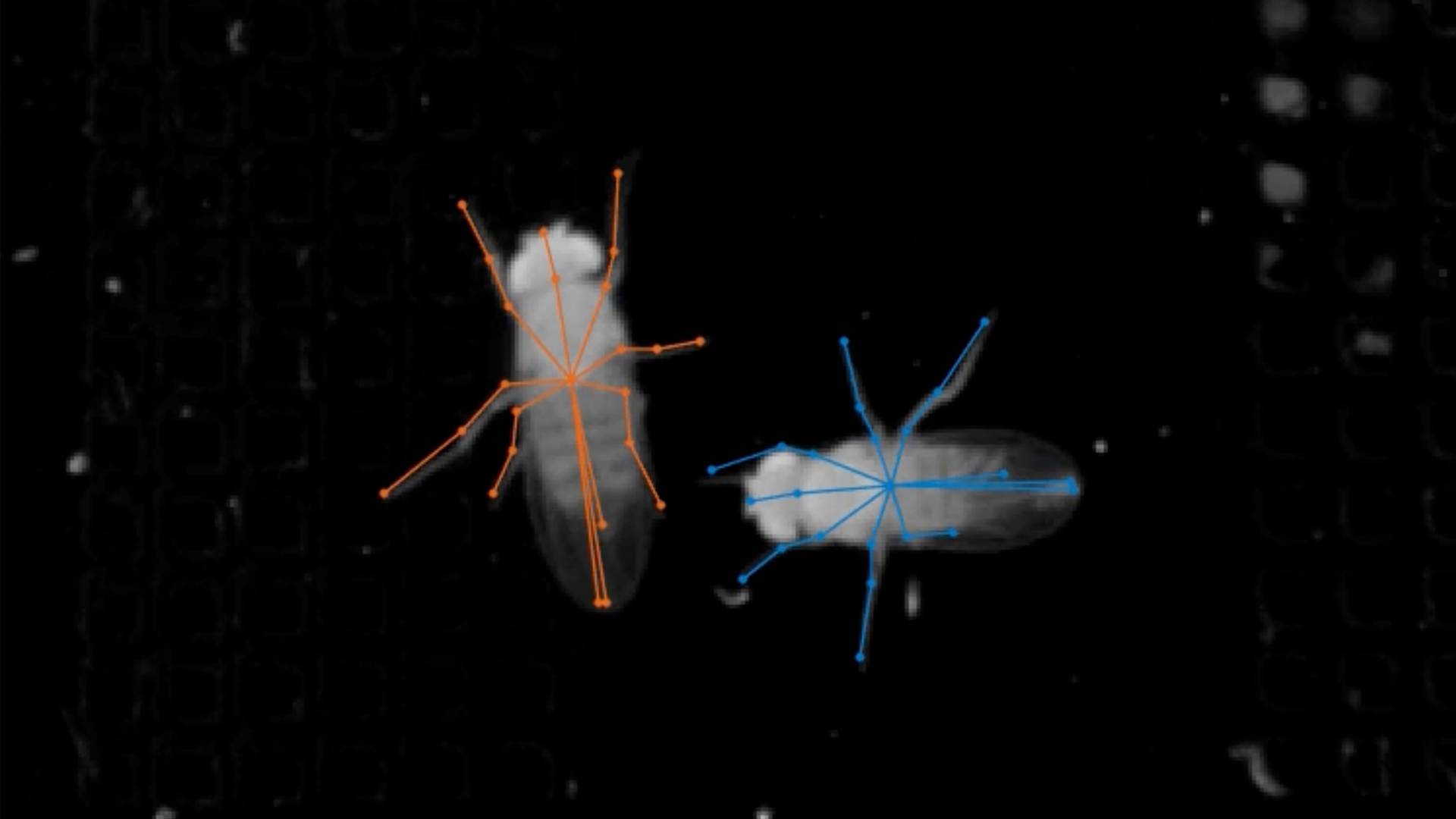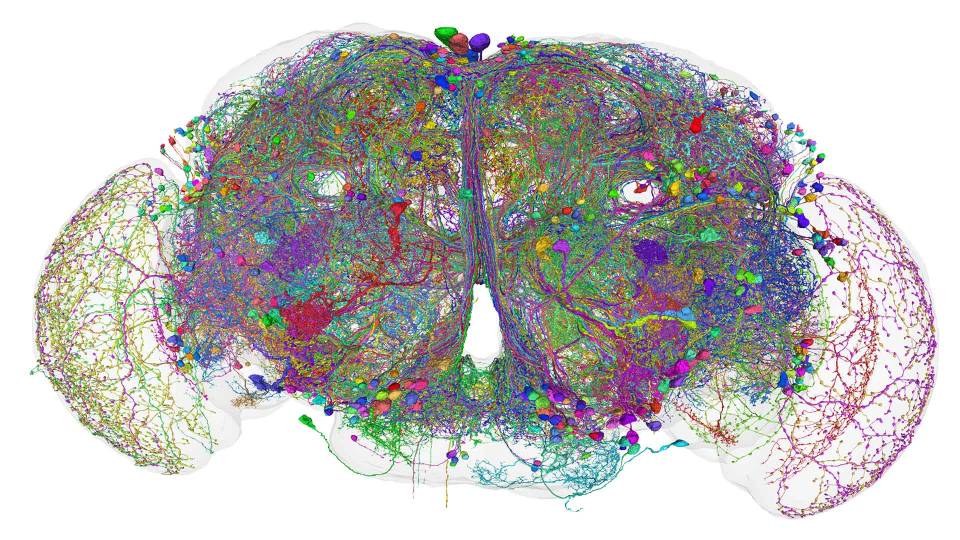A male fruit fly (blue) follows a female (red) during their courtship. The colored lines track every movement of each limb and body segment using SLEAP, a motion-capture program designed by Talmo Pereira, a 2021 Ph.D. graduate of Princeton, and his colleagues in the Murthy lab.

Mala Murthy
Love songs are at least as popular in the animal kingdom as on the radio. The importance of musically serenading your true love has driven plotlines from Twelfth Night to The Trumpet of the Swan to Happy Feet.
The latest exploration of music in the natural world is taking place in Mala Murthy’s lab at the Princeton Neuroscience Institute, where Murthy and her research group have used neural imaging, optogenetics, motion capture, modeling and artificial intelligence to pinpoint precisely where and how a fruit fly’s brain toggles between its standard solo and its mating serenade. Their research appears in the current issue of the journal Nature.
“For me it is very rewarding that, in a team of exceptional scientists coming from different backgrounds, we joined forces and methodologies to figure out the key characteristics of a neural circuit that can explain a complex behavior — the patterning of courtship song,” said Frederic Römschied, first author on this paper and a former postdoctoral fellow in Murthy’s lab. He is now a group leader at the European Neuroscience Institute in Göttingen, Germany.
“It might be a surprise to discover that the fruit flies buzzing around your banana can sing, but it’s more than music, it’s communication,” said Murthy, the Karol and Marnie Marcin ’96 Professor and the director of the Princeton Neuroscience Institute. “It’s a conversation, with a back and forth. He sings, and she slows down, and she turns, and then he sings more. He’s constantly assessing her behavior to decide exactly how to sing. They’re exchanging information in this way. Unlike a songbird, belting out his song from his perch, he tunes everything into what she’s doing. It’s a dialogue.”
By studying how these tiny brains work, researchers hope to develop insights that will prove useful in the larger and more complex brains that are millions of times harder to study. In particular, Murthy’s team is trying to determine how the brain decides what behavior is appropriate in which context.
“One of the brain’s most impressive abilities is its capacity to generate patterns of behavior that are appropriate in particular contexts,” said Max Aragon, a fifth-year graduate student in Murthy’s lab. “For example, the way you speak to a group of close friends in a coffee shop is likely very different from the way you speak to relatives at dinner. What is happening in the brain that allows us to generate this behavioral flexibility?”

Murthy and her colleagues have mapped out the first whole brain connectome: the total set of neurons and their connections in a Drosophila melanogaster (fruit fly) brain.
A fruit fly courtship in song
Similar to crickets and grasshoppers, fruit flies also use their wings to sing, but they extend and vibrate one wing at a time. For Drosophila melanogaster, only the male fruit flies sing. The females respond by moving away or slowing down to allow the male to approach. Male fruit flies can’t force mating; he has to woo her.
“He chases her and sings to her, and she chooses whether or not to slow down for him," Murthy said. "They’ll go through this dance for 20 minutes or so, until she slows down enough to mate. He’ll sing hundreds of the ‘song bouts’ to her during their courtship.
The simplest song bouts last only a fraction of a second, and the complex bouts can go on for several seconds.
In an audio clip of the fruit fly serenade, amplified thousands of times, you can hear a series of pulses intermixed with more musical tones.
“That’s the real song. It’s not slowed down or sped up,” Murthy said. “It’s just so quiet that even if the fruit fly landed in your ear, you wouldn’t hear it. You need to amplify it, because fruit flies have tiny little wings, but that’s it. That’s actually what he’s singing to her.”
The “pulses” are the sounds that the male makes when he’s further away, to get the female’s attention, and the more tuneful serenading that he does up close is the “sine” song. There’s a third mode, “complex,” which flips back and forth between pulse and sine songs.
As he chases and she evades or encourages his approach, the song flickers back and forth between simple pulse-only songs and complex pulse and sine serenades. She seems to like the alternating pattern as well. In the clinical language of academia, the paper says, “Songbout complexity may be desirable to the female, as the majority of bouts immediately preceding copulation are complex.”
Bold bets at Princeton on curiosity-driven research
Several Princeton resources contributed to answering the question of how the fruit fly brain signals the right song for the right context. The team used LEAP (LEAP Estimates Animal Pose) and its next generation SLEAP (Social LEAP Estimates Animal Poses), both deep-learning-based motion-capture tools developed by a previous Princeton collaboration, that quantified exactly how the flies are moving and where they are in relation to each other. In addition, the neural imaging of the flies was performed at the endowment-funded Bezos Center for Neural Circuit Dynamics.
“Princeton is a special place that encourages collaboration between scientists with diverse expertise, from computational neuroscience to physics and beyond,” Aragon said. “PNI in particular is a relatively small institute, so there’s a good chance of running into someone with a great idea that happens to exactly solve a problem you’ve been facing in your work.”
“Being at Princeton, working with Mala Murthy, created an extremely supportive atmosphere, where novel ideas were always encouraged, and the path from idea to experiment was free from bureaucratic hurdles,” agreed Römschied.
Using SLEAP, the researchers showed that the key cause for the switch between solo mode and serenade mode was proximity — how close together the male and female fruit flies were.
“Our work uncovered a toggle switch in his brain,” Murthy said. “When the switch is engaged, he can sing a beautiful, long song, and then immediately, as he separates from her just a little bit, the switch disengages, and he’s just singing one simple song. We showed that this one neural circuit operates in two regimes via the switch. You don’t need a separate circuit to generate a different song. This had not been shown before.
“I love the idea of a circuit that toggles between regimes,” she continued. “It’s just so simple. You don’t have to keep making new circuits for every new behavior. It’s such a nice, elegant solution.”
“Flexible circuit mechanisms for context-dependent song sequencing,” by Frederic A. Römschied, Diego A. Pacheco, Max J. Aragon, Elise C. Ireland, Xinping Li, Kyle Thieringer, Rich Pang and Mala Murthy, appears in the Oct. 11 issue of Nature (DOI: 10.1038/s41586-023-06632-1) and was supported by the Bezos Center for Neural Circuit Dynamics at the Princeton Neuroscience Institute, the German Research Foundation (DFG Forschungsstipendium RO 5787/1-1 and RO 5787/2-1 to F.A.R.), the Sloan-Swartz Foundation to R.P., the Howard Hughes Medical Institute (Faculty Scholar Award to M.M.), the NIH BRAIN Initiative (NS104899 to M.M.), and an NIH NINDS R35 Research Program Award to M.M.





